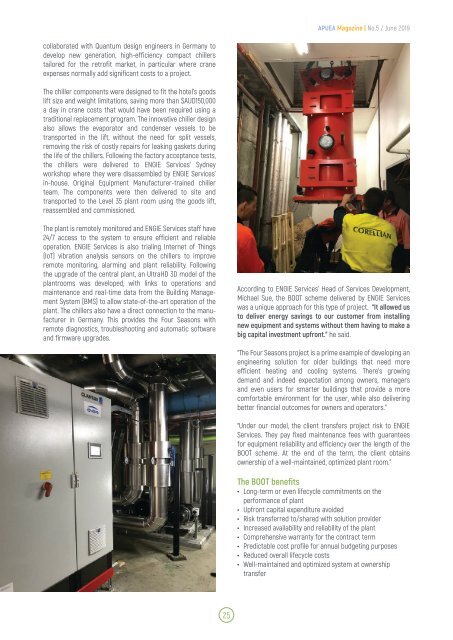APUEA Magazine-no.5 June 2019
You also want an ePaper? Increase the reach of your titles
YUMPU automatically turns print PDFs into web optimized ePapers that Google loves.
<strong>APUEA</strong> <strong>Magazine</strong> | No.5 / <strong>June</strong> <strong>2019</strong><br />
collaborated with Quantum design engineers in Germany to<br />
develop new generation, high-efficiency compact chillers<br />
tailored for the retrofit market, in particular where crane<br />
expenses normally add significant costs to a project.<br />
The chiller components were designed to fit the hotel’s goods<br />
lift size and weight limitations, saving more than $AUD150,000<br />
a day in crane costs that would have been required using a<br />
traditional replacement program. The innovative chiller design<br />
also allows the evaporator and condenser vessels to be<br />
transported in the lift, without the need for split vessels,<br />
removing the risk of costly repairs for leaking gaskets during<br />
the life of the chillers. Following the factory acceptance tests,<br />
the chillers were delivered to ENGIE Services’ Sydney<br />
workshop where they were disassembled by ENGIE Services’<br />
in-house, Original Equipment Manufacturer-trained chiller<br />
team. The components were then delivered to site and<br />
transported to the Level 35 plant room using the goods lift,<br />
reassembled and commissioned.<br />
The plant is remotely monitored and ENGIE Services staff have<br />
24/7 access to the system to ensure efficient and reliable<br />
operation. ENGIE Services is also trialing Internet of Things<br />
(IoT) vibration analysis sensors on the chillers to improve<br />
remote monitoring, alarming and plant reliability. Following<br />
the upgrade of the central plant, an UltraHD 3D model of the<br />
plantrooms was developed, with links to operations and<br />
maintenance and real-time data from the Building Management<br />
System (BMS) to allow state-of-the-art operation of the<br />
plant. The chillers also have a direct connection to the manufacturer<br />
in Germany. This provides the Four Seasons with<br />
remote diagnostics, troubleshooting and automatic software<br />
and firmware upgrades.<br />
According to ENGIE Services’ Head of Services Development,<br />
Michael Sue, the BOOT scheme delivered by ENGIE Services<br />
was a unique approach for this type of project. “It allowed us<br />
to deliver energy savings to our customer from installing<br />
new equipment and systems without them having to make a<br />
big capital investment upfront.” he said.<br />
“The Four Seasons project is a prime example of developing an<br />
engineering solution for older buildings that need more<br />
efficient heating and cooling systems. There’s growing<br />
demand and indeed expectation among owners, managers<br />
and even users for smarter buildings that provide a more<br />
comfortable environment for the user, while also delivering<br />
better financial outcomes for owners and operators.”<br />
“Under our model, the client transfers project risk to ENGIE<br />
Services. They pay fixed maintenance fees with guarantees<br />
for equipment reliability and efficiency over the length of the<br />
BOOT scheme. At the end of the term, the client obtains<br />
ownership of a well-maintained, optimized plant room.”<br />
The BOOT benefits<br />
• Long-term or even lifecycle commitments on the<br />
performance of plant<br />
• Upfront capital expenditure avoided<br />
• Risk transferred to/shared with solution provider<br />
• Increased availability and reliability of the plant<br />
• Comprehensive warranty for the contract term<br />
• Predictable cost profile for annual budgeting purposes<br />
• Reduced overall lifecycle costs<br />
• Well-maintained and optimized system at ownership<br />
transfer<br />
25




